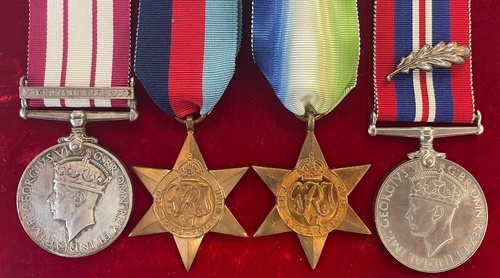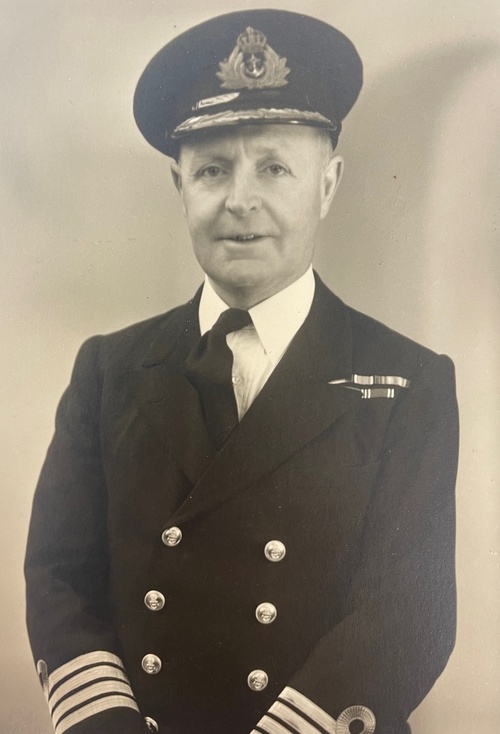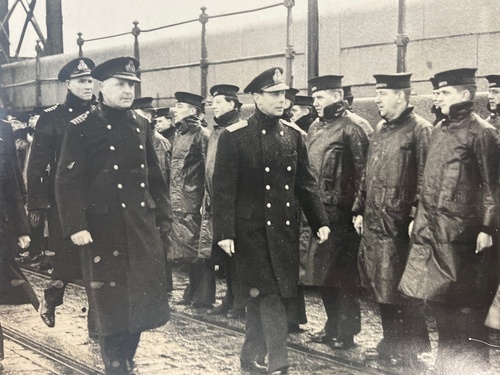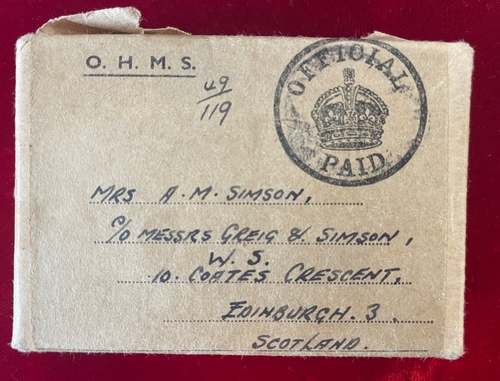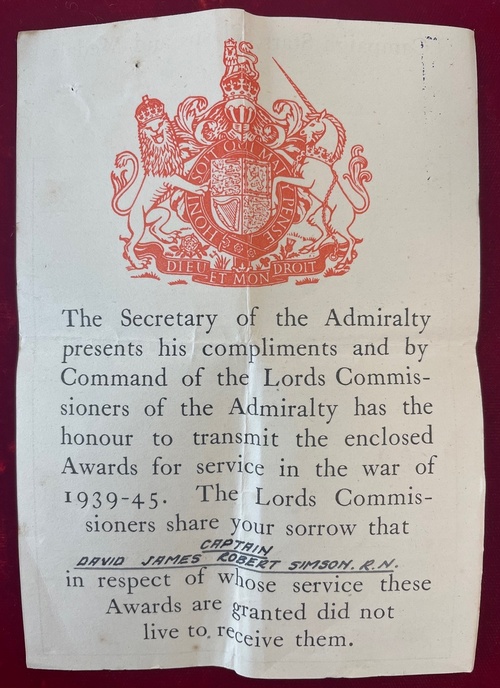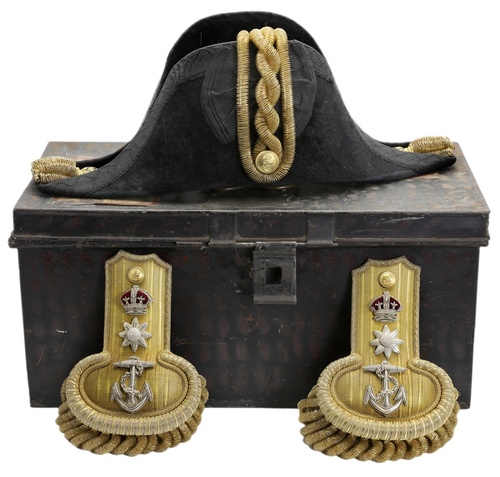Auction: 25001 - Orders, Decorations and Medals
Lot: 79
The campaign group of four awarded to Captain D. J. R. Simson, Royal Navy, who was killed by a German sniper on 23 May 1940 while serving aboard H.M.S. Keith at Boulogne when the port was infiltrated by German troops; he also received a posthumous 'mention'
Naval General Service 1915-62, 1 clasp, Palestine 1936-1939 (Capt. D. J. R. Simson. R.N.); 1939-1945 Star; Atlantic Star; War Medal 1939-45, with M.I.D. oak leaf, these in box of issue and with named Condolence slip, extremely fine (4)
M.I.D. London Gazette 27 August 1940.
David James Robert Simson was born on 7 September 1892, later studying at Osborne and then Dartmouth, taking the King's Medal. He was promoted Midshipman on 15 January 1910 and served aboard Russell and Lancaster in the Mediterranean and with Lion during her first commission. Later being further advanced Sub-Lieutenant on 15 April 1913, during the Great War he served on the destroyer Acasta and battleship King George V at the Battle of Jutland.
From March 1918 he first held command on Usk. Simson was promoted to Lieutenant-Commander on 15 January 1923, Commander on 30 June 1928, and between 1929-30 was the Executive Officer at the boys' training establishment at Shotley. After this time he returned to serving aboard destroyers and commanded, among other vessels, Vanquisher in the Mediterranean, Valorous in the Home Fleet, and between 1934-35 the cruiser Cumberland in China. During the Naval Review in 1935 Simson commanded Thanet before commanding Vivien and Winchelsea and from May 1936 the new destroyer Grenville. He was promoted Captain on 30 June 1936 and was later placed in command of Codrington from 24 August 1939 until 26 November and was then in charge of Keith from 15 February 1940.
On 10 May 1940, the Germans launched their invasion of France and the Low Countries. That day Keith and her sister Boreas escorted the light cruisers Arethusa and Galatea as they carried bullion from the Dutch port of Ijmuiden to the United Kingdom for safe keeping. On 12 May, she returned to the Hook of Holland in the Netherlands to evacuate Allied troops. After the destroyer Whitley had to be run aground on 19 May when she was damaged by German aircraft, she was scuttled by Keith. Keith was one of three destroyers on 21 May that evacuated 468 civilians from France. Two days later she was in Boulogne-sur-Mer, loading British troops at the Gare Maritime to be evacuated and was attacked by German troops who had infiltrated the port area. Simson was shot by a sniper and several crew members and a dozen soldiers were also killed.
He is commemorated on the Chatham Naval Memorial. Keith sailed for the UK immediately afterwards and was later active during Operation Dynamo. She was sunk off Dunkirk by German air attacks on the morning of 31 May 1940.
Brigadier W. A. Fox-Pitt, who served as commander of the 20th Guards Brigade to defend Boulogne and was subsequently awarded a D.S.O., wrote to Simson's brother, Lieutenant-Colonel A. M. Simson on 20 August 1946:
'My only means of communication with England during the battle was through H.M. Ships so that if there was no destroyer in, I was completely out of touch. The last destroyers left Boulogne during the night of the 23/24th and I was out of touch with England until H.M.S. Keith came in about 3p.m. By this time I had ordered a withdrawal into a closer perimeter round the Harbour in order to prevent the Germans getting round my northerly flank and cutting us off.
I went aboard the Keith and had a conference with Simson and discussed the situation and sent off certain signals explaining the progress of the battle. I also had a very welcome cup of tea and gave one of the officers a letter to post for me in England. We were both pretty certain then that it was a waste of life to continue to hold Boulogne as my casualties were mounting pretty rapidly.
However, a signal arrived while I was on board from the Prime Minister saying "You will evacuate all non military personnel (Pioneer Corps etc), the 20th Guards Brigade will fight it out". I then left the Keith and went and saw my Battalion Commanders and gave further orders for holding the town. I was away about two hours and then returned to the Keith, for further orders. While on board I received the signal telling to evacuate. As it was getting late I went ashore immediately to get my orders out and understood that the destroyers would put out and come back again after dark for the evacuation. I had only just left the ship when the air attack started and during the attack Simson was killed. The destroyers left the port as soon as they could and I continued with my arrangements for evacuation. I did not know that Simson had been killed until the destroyers came in later. Condor of the Whitshed, was then left in command of the Flotilla. Just before dark the destroyers came in again and I was told that I must evacuate immediately. This meant putting my plan in motion very quickly, but eventually all the troops were evacuated by about 2 a.m. on the 25th.
My recollections of your brother are pretty vivid. I found him most helpful in concocting signals to England. He was at all times thoroughly calm and collected and very quick to grasp the situation on shore. He realised the importance of the destroyers as my only link with Dover, and I fear it may have been for this reason that he stayed in the port so long, as the destroyers were a very tempting target. I don't remember the Germans being within small arms range of the Keith at the time of the air attack, but the aircraft were machine gunning as well as dropping bombs. The real battle between the destroyers and the land targets took place later when the destroyers completely silenced the Germans for the rest of the night and I saw a German tank knocked out by one of their guns myself.'
Sold together with the following archive comprising:
i)
The handwritten letter to Mrs Simson from Admiral Sir B. H. Ramsay, dated 25 May, written from Dover expressing his deepest sympathy upon his death.
ii)
Officer's bicorn hat, epaulettes and sword belt in named tin, together with Greatcoat Epaulettes.
iii)
Two sets of his pre-Second World War miniature medals, with riband bars.
iv)
Silver Oar rowing prize for the VIIIth Flotilla Officers Race 1925 H.M.S. Venturous, silver napkin ring and silver clothes brush.
v)
Letter to his wife and that to his brother from Fox-Pitt, besides photographs and assorted calling cards (5), newspaper cutting, Blue Lists (2), The List 1940, black armbands (2), besides a four leaf clover and lucky heather.
Subject to 20% VAT on Buyer’s Premium. For more information please view Terms and Conditions for Buyers.
Estimate
£700 to £900
Starting price
£700

